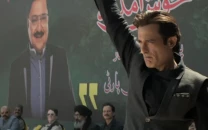A defining nexus: Pakistan's media and the Supreme Court
Following the CJ's restoration, court reporting as we know it changed entirely – with far-reaching effects.

Following the CJ's restoration, court reporting as we know it changed entirely.
Fewer still will argue that it was the news media and its extensive coverage of the institution that was instrumental in bringing the apex court into the limelight during Justice Chaudhry’s tenure.
First, the media meticulously covered the Lawyers’ Movement for the restoration of the judiciary. But it didn’t end there.
That was just the beginning of a relationship that would define the narrative of modern day Pakistan.
Following the restoration, court reporting as we know it changed entirely – and with far-reaching effects.
Chaudhry’s Courtroom One was a centre for news-hungry media outlets. A testament to this reality is the number of antennas standing alert through the day in the parking lot and the main gate of the Supreme Court building.
There was a time before 2007 that many media houses did not even have dedicated court reporters. One senior legal affairs reporter, Khalid Azeem, recalls that reporters rarely visited the Supreme Court in the past. In case the court decided a case, the court registrar would call journalists on a fixed day for a visit to the court.
Things have changed. Drastically, at that.
Today, special arrangements for the press are made inside Court Room One, whereas previously there were none. On average, 50 correspondents of different media organizations packed in there daily to cover judicial proceedings.
.....................................................................................................................................................
.....................................................................................................................................................
Even though live coverage is still not allowed in court premises, the electronic media has managed to give a blow-by-blow account of judicial proceedings, through live tweeting and audio beepers on TV among other methods.
Perhaps most tellingly, it was no longer about orders or judgments. It was now a matter of remarks and observations. It was these that dominated the day almost daily, making for front page headlines and breaking news.
Nasir Iqbal, a legal affairs correspondent, said that it was only under Chaudhry’s tenure that court coverage became a hectic task.
But it wasn’t just one-way traffic: The media would also often find itself front and centre. Judges would refer to news stories during case hearings. In fact, a number of suo motu actions were taken on media reports. Journalists relished the immediate attention of having their story mentioned or taken up. It was a matter of pride and of competition.
But that’s just when the going was good.
The Supreme Court has been sensitive to media criticism, and many journalists who hadn’t joined the bandwagon of mutual admiration were served notices. Alternatively, a number of show-cause notices were also issued to the court’s own media department when it was felt that their activities were not given due coverage.
“It was considered our failure if the media was not giving coverage to a gathering or a meeting of a district bar association with Justice Chaudhry,” an official from the courts’ media department told The Express Tribune.
Published in The Express Tribune, December 11th, 2013.



















COMMENTS
Comments are moderated and generally will be posted if they are on-topic and not abusive.
For more information, please see our Comments FAQ